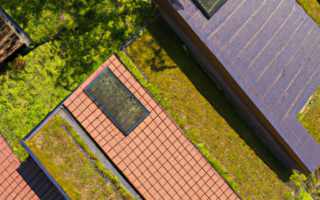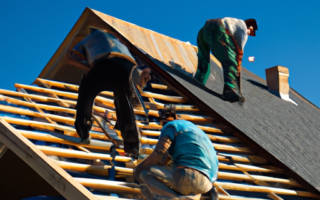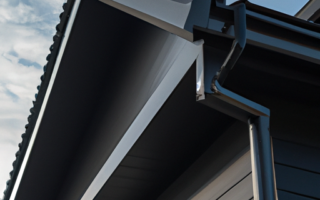Importance of Proper Roof Design and Construction
Proper roof design and construction play a crucial role in ensuring the longevity and safety of a building. When it comes to building or renovating a roof, there are several essential factors that need to be considered. In this article, we will discuss the importance of proper roof design and construction, and why it should never be overlooked.
One of the primary reasons why proper roof design and construction are important is the impact they have on the overall durability of the building. A well-designed roof is structurally sound and able to withstand various weather conditions, such as heavy rain, snow, strong winds, and even earthquakes. It acts as the first line of defense against these elements, protecting the interior of the building and its occupants.
In addition to durability, proper roof design and construction also ensure energy efficiency. A roof that is poorly insulated or has gaps and leaks can lead to significant heat loss during the winter and heat gain during the summer. This, in turn, puts a strain on the heating and cooling systems, resulting in higher energy consumption and costs. By employing proper design practices, such as using insulation materials and sealing any potential air leaks, a building can greatly improve its energy efficiency and reduce its carbon footprint.
Furthermore, proper roof design and construction also take into account the specific needs and characteristics of the building. Factors such as the location, climate, and purpose of the structure all play a role in determining the most suitable roof design. For example, a roof in an area prone to heavy snowfall may require a steeper slope to allow snow to slide off easily, preventing the accumulation of excessive weight. Similarly, a building used for industrial purposes may require a roof design that can accommodate ventilation systems or the installation of rooftop equipment.
Lastly, proper roof design and construction ensure the safety of the occupants. A well-built roof reduces the risk of structural failures such as collapses or leaks, which can cause damage to property and pose a threat to human lives. Additionally, a properly designed roof takes into account fire safety regulations, ensuring adequate access for firefighters and the installation of fire-resistant materials.
In conclusion, the importance of proper roof design and construction cannot be overstated. From durability and energy efficiency to meeting specific needs and ensuring safety, a well-designed roof enhances the overall quality and functionality of a building. It is crucial for both residential and commercial structures to invest in professional roof design and construction to ensure the longevity and safety of the property.
Key Considerations for Choosing the Right Roofing Material
When it comes to roof construction, choosing the right roofing material is of utmost importance. The type of material you select not only impacts the aesthetics of your home but also plays a crucial role in protecting your house from the elements. With a wide variety of options available in the market, it can be overwhelming to make the right choice. Here are some key considerations to keep in mind while selecting the perfect roofing material for your project.
1. Climate: The climate in your region plays a significant role in determining the most suitable roofing material. If you live in an area with high rainfall, you would want a material that is durable and provides excellent water resistance. On the other hand, if you reside in a region with extreme heat, a material that offers good insulation and reflects sunlight could be a better choice.
2. Cost: Budget is an essential factor to consider when choosing roofing materials. While some materials may seem cheaper upfront, they may require more frequent repairs and maintenance down the line, adding up to the overall cost. It’s crucial to strike a balance between upfront expenses and long-term costs to ensure the best value for your investment.
3. Durability: Roofing materials vary in their longevity and durability. Factors such as the material’s resistance to impact, wind, fire, and other elements should be taken into account. Opting for a durable material will ensure that your roof withstands the test of time and requires minimal repairs or replacements.
4. Aesthetics: The roofing material you choose should complement the architectural style of your home. Whether you prefer a traditional, modern, or rustic look, there are roofing materials available to match your preferences. Consider the color, texture, and overall appearance of the material to ensure it enhances the visual appeal of your house.
5. Maintenance Requirements: Some roofing materials require more maintenance than others. It’s essential to consider how much time and effort you are willing to spend on maintaining the roof. For instance, while asphalt shingles are low maintenance, wood shingles require regular inspections and treatments to prevent rot and decay.
6. Eco-Friendliness: If environmental sustainability is a priority for you, choosing eco-friendly roofing materials can help reduce your carbon footprint. Options such as metal roofs made from recycled materials or green roofs with natural vegetation can provide excellent insulation and contribute to energy efficiency.
By carefully considering these factors, you can choose the roofing material that best suits your needs and preferences. Remember to consult with professionals to get expert advice and make an informed decision. Investing in the right roofing material will not only enhance the beauty of your home but also provide long-lasting protection for years to come.
Essential Structural Factors for a Strong and Long-lasting Roof
When it comes to roof construction, there are several essential factors to consider in order to ensure a strong and long-lasting structure. These structural elements play a crucial role in the durability and stability of the roof, protecting the building and its occupants from various weather conditions.
The first factor to consider is the roof pitch or slope. This refers to the angle at which the roof rises from its lowest point to its highest. A steeper pitch allows water to quickly run off the roof, preventing water pooling and potential damage. Additionally, a higher pitch enhances the structural integrity of the roof, making it more resistant to wind uplift forces.
The roof framing is another crucial aspect of roof construction. The framing includes trusses or rafters, which provide the main support for the roof. These must be designed and constructed correctly to ensure proper weight distribution and load-bearing capacity. Using high-quality materials and following engineering guidelines is essential for a strong and durable roof structure.
In addition to the framing, the underlayment is a vital component that provides an extra layer of protection between the roofing material and the roof deck. Typically, an asphalt-saturated felt or synthetic underlayment is used. It acts as a barrier against water infiltration and helps to prevent leaks and damage to the underlying structure.
Ventilation is another important factor in roof construction. Adequate airflow helps to regulate temperature and moisture levels in the attic or upper part of the building. This helps to prevent condensation, which can lead to mold growth and deterioration of the roof materials. Proper ventilation also helps to extend the lifespan of the roof, as excessive heat can cause premature aging and degradation.
Lastly, the roofing material itself is a critical consideration. There are various options available, including asphalt shingles, metal roofing, tiles, and more. Factors such as durability, aesthetics, cost, and climate suitability should be taken into account when selecting the appropriate roofing material.
Overall, paying attention to these essential structural factors during roof construction is essential for ensuring a strong and long-lasting roof. From the roof pitch and framing to the underlayment, ventilation, and choice of roofing material, each element plays a crucial role in the overall performance and longevity of the roof.
Critical Maintenance Practices for a Durable Roof
Maintaining a durable roof is essential for the long-term protection and structural integrity of any building. Regular roof maintenance practices can help prevent costly repairs and extend the lifespan of your roof. To ensure your roof remains in good condition, there are several critical maintenance practices to consider:
1. Regular Inspections: Regularly inspect your roof for any signs of damage or wear. Look for cracked or missing shingles, loose flashing, or any signs of water damage. Catching these issues early can prevent them from worsening and causing more extensive damage.
2. Cleaning Gutters: Clearing debris, such as leaves and twigs, from your gutters is crucial for proper drainage. Clogged gutters can lead to water buildup, which can seep into the roof and cause leaks or structural damage. Regularly clean your gutters and downspouts to ensure water flows freely.
3. Trim Overhanging Trees: Tree branches that hang over your roof can cause damage, especially during storms or high winds. Falling branches can puncture the roof or scratch the surface. Trim back any branches that come into contact with your roof to prevent potential damage.
4. Remove Moss and Algae: Over time, moss and algae can accumulate on your roof, particularly in shaded areas. These organisms can trap moisture and cause shingle deterioration. Use a moss and algae cleaner to remove them and prevent further growth.
5. Fix Leaks Promptly: If you notice any signs of a leak, such as water spots on your ceiling or damp areas on your walls, take immediate action to fix the issue. Ignoring leaks can lead to extensive water damage and mold growth, affecting not only your roof but also the interior of your building.
6. Hire Professionals: While some maintenance tasks can be done by homeowners, it is advisable to hire professional roofers for comprehensive inspections and complex repairs. They have the expertise and equipment to identify potential issues and ensure proper maintenance.
By implementing these critical maintenance practices, you can significantly prolong the lifespan of your roof and minimize the need for expensive repairs. Regular inspections and proactive care will ensure that your roof remains durable and provides optimal protection for your building for years to come.



